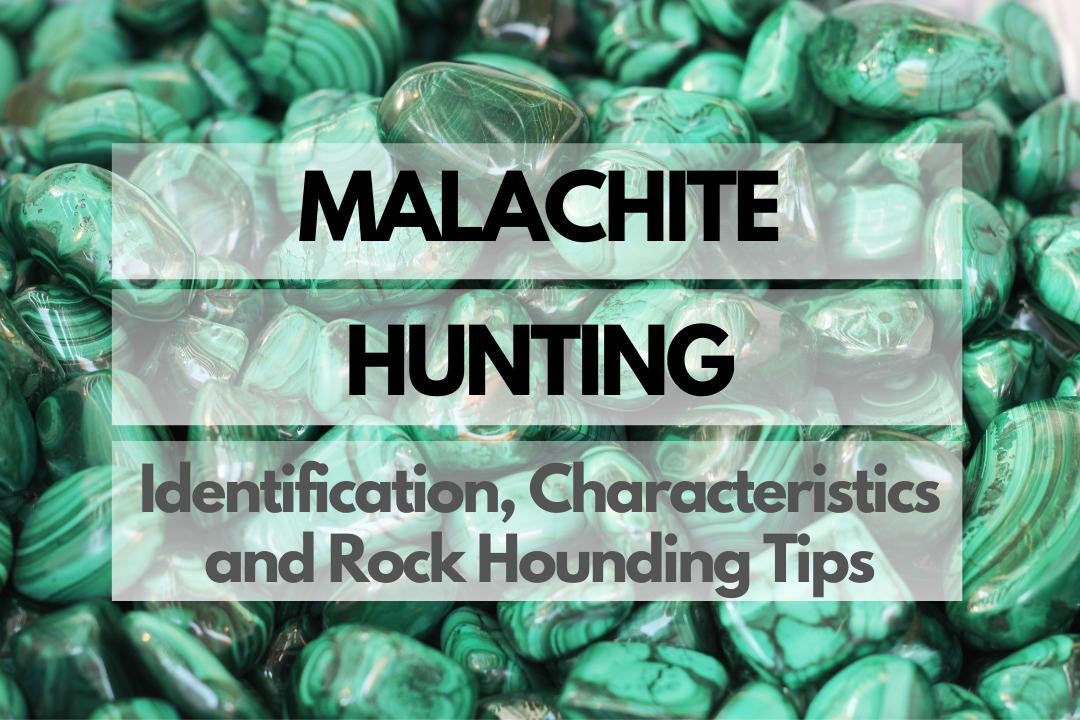Get ready to embark on an exciting journey into the world of malachite hunting! This beautiful green mineral has captivated rock hounds and collectors alike for centuries with its vibrant colors and unique patterns. In this article, we’ll explore the history and origins of malachite, learn how to identify it, and delve into its various uses and values. So let’s dive in and discover the allure of this stunning gemstone!
History & Origin of Malachite
Malachite has a rich history dating back thousands of years. Its name comes from the Greek word “malache,” meaning “mallow” in reference to its green color, similar to that of mallow leaves. The mineral has been used as a decorative material and pigment since ancient times. In ancient Egypt, it was ground into a fine powder and used as eye makeup, while the ancient Greeks and Romans used it to create green paints. Malachite has also been associated with various mystical properties and healing energies throughout history, and it has been a popular choice for carving into talismans and amulets.
Malachite Identification & Physical Properties
Here’s a summary of the key physical properties of malachite to help you identify this unique mineral.
| Property | Value |
|---|---|
| Chemical Formula | Cu2CO3(OH)2 |
| Crystal System | Monoclinic |
| Cleavage | Good in one direction |
| Luster | Adamantine to dull |
| Streak | Green |
| Transparency | Translucent to opaque |
| Specific Gravity | 3.6 – 4.0 |
Malachite Colors
Malachite is best known for its striking green color, which ranges from light green to deep, almost black-green. The color variations are due to differences in copper content within the mineral. Malachite often displays unique and intricate banding patterns, which can include concentric circles, swirls, or stripes.
Malachite Hardness
Malachite has a Mohs hardness of 3.5 to 4, making it a relatively soft mineral. This characteristic makes it easy to carve and shape but also means it can be prone to scratches and wear. If used in jewelry, malachite should be set in protective settings or reserved for pieces that won’t be subjected to rough handling.
Malachite Types
Botryoidal Malachite
Botryoidal malachite features a rounded, grape-like formation that creates a unique, bubbly texture. This type of malachite is highly sought after for its intriguing appearance and is often used for decorative purposes.
Stalactitic Malachite
Stalactitic malachite forms in elongated, cylindrical shapes, similar to stalactites found in caves. These formations can display intricate banding patterns and are often used as display pieces or incorporated into jewelry designs.
Fibrous Malachite
Fibrous malachite consists of tightly packed, needle-like crystals that give the mineral a silky appearance. This type of malachite is less common than other forms and is highly valued by collectors for its unique texture and crystal structure.
Malachite Uses
Malachite has a variety of uses, including:
- Jewelry: Due to its vibrant green color and unique patterns, malachite is often used for beads, cabochons, and other decorative elements in jewelry designs.
- Carvings: Malachite’s softness makes it easy to carve, and it has been used to create intricate sculptures, boxes, and decorative objects.
- Pigments: Historically, malachite was ground into a powder and used as a green pigment in paints and makeup. Healing and spiritual practices: Many people believe that malachite has metaphysical properties that promote healing, protection, and transformation, making it a popular choice for crystal enthusiasts and energy workers.
How Much Is Malachite Worth?
The value of malachite can vary greatly depending on factors such as color, pattern, size, and overall quality. Small, lower-quality specimens can be found for just a few dollars, while larger, high-quality pieces can fetch hundreds or even thousands of dollars. In general, the more vibrant and intricate the patterns, the more valuable the malachite.
Malachite Rock Hounding Tips
Ready to embark on a thrilling malachite hunting adventure? Here are some essential tips and tricks to help you have a successful and enjoyable experience!
Essential Tools and Equipment
Before setting out on your malachite hunting expedition, make sure you’re equipped with the right tools and gear:
- Rock hammer: A sturdy rock hammer is a must-have for breaking open rocks and extracting specimens.
- Chisels and pry bars: These tools come in handy for prying out stubborn pieces of malachite or working in tight spaces.
- Hand lens or magnifying glass: A magnifying glass helps you examine the finer details of your finds and identify malachite more easily.
- Sturdy gloves: Protect your hands from sharp rocks and tools with a good pair of gloves.
- Backpack or collecting bag: Bring along a durable bag to store and transport your malachite specimens.
- GPS device or mapping app: These can help you navigate to prime malachite hunting locations and keep track of your finds.
Safety Tips
Rock hounding can be a fun and rewarding activity, but it’s important to prioritize safety. Keep these tips in mind:
- Always let someone know where you’re going and when you plan to return.
- Bring a first aid kit, plenty of water, and snacks to ensure you’re prepared for emergencies.
- Wear appropriate clothing, such as sturdy boots, long pants, and a hat to protect yourself from the elements and potential hazards.
- Be aware of your surroundings and watch out for potential hazards, such as loose rocks, steep cliffs, or wildlife.
- Respect private property and always ask for permission before entering someone’s land.
Malachite Hunting: Where to Find Malachite
Malachite can be found in various locations around the world, often in copper-rich areas. The mineral is particularly abundant in the Democratic Republic of the Congo, Zambia, Russia, and the southwestern United States. The following table provides a more detailed overview of specific malachite hunting sites:
| Site/Area | Location |
|---|---|
| Bisbee | Arizona, United States |
| Morenci Mine | Arizona, United States |
| Chessy-les-Mines | Rhône, France |
| Ural Mountains | Russia |
| Katanga Province | Democratic Republic of the Congo |
| Kabwe | Zambia |
Caring For Your Malachite
To preserve the beauty and value of your malachite specimens, follow these care tips:
- Store malachite away from direct sunlight, as prolonged exposure can cause the color to fade.
- Avoid exposing malachite to harsh chemicals or cleaning agents, which can damage its surface.
- Keep malachite away from harder minerals and gemstones to prevent scratches.
- For jewelry and polished specimens, clean malachite with a soft cloth and warm, soapy water. Rinse thoroughly and dry gently.
Additional Resources
If you’re looking for more information on malachite hunting and related topics, check out these resources:
- Mindat.org: A comprehensive online database of minerals, including detailed information on malachite and its localities.
- United States Geological Survey (USGS): Offers a wealth of geological information, including maps and resources for rock hounds.
- Rock & Gem Magazine: A monthly publication dedicated to the world of rock collecting, lapidary, andmineralogy, featuring articles, tips, and advice for enthusiasts.
- Rock Hounds Facebook group: A community of rock collectors and enthusiasts who share finds, experiences, and advice.
Additional Malachite FAQs
Here are some frequently asked questions about malachite that can help deepen your understanding of this fascinating mineral:
What are the benefits of Malachite?
Malachite is prized for its unique green color, intricate patterns, and banding. It is often used in jewelry, decorative items, and ornamental carvings. Malachite is also an essential mineral in the extraction of copper.
Do Malachite have any healing properties?
While many people believe that malachite possesses healing properties, such as promoting emotional balance, reducing stress, and enhancing intuition, there is no scientific evidence to support these claims. It is essential to remember that healing crystals should not replace professional medical advice and treatment.
Do Malachite have any spiritual meaning?
In various cultures and belief systems, malachite is associated with spiritual meanings and symbolism. It is often considered a stone of transformation and protection, believed to help with personal growth and guard against negative energies. However, these beliefs are subjective and should be taken with a grain of salt.
Do I need a permit to go Malachite hunting?
Permit requirements for rock hunting vary depending on the location and land ownership. In the United States, many public lands managed by the Bureau of Land Management (BLM) and the United States Forest Service (USFS) allow casual rock hunting without a permit. However, some areas may have restrictions or require a permit, especially for commercial or large-scale collecting. It’s essential to research local regulations and obtain necessary permits before embarking on your malachite hunting adventure. For more information on permits and regulations in the United States, visit the Bureau of Land Management and the United States Forest Service websites.
Closing Thoughts
Malachite hunting is an exciting and rewarding activity that can lead to beautiful and valuable specimens. By equipping yourself with the right tools, knowledge, and resources, you can enhance your rock hounding experience and make the most of your adventure. So, gather your gear, do your research, and get ready to embark on a thrilling malachite hunting expedition!

